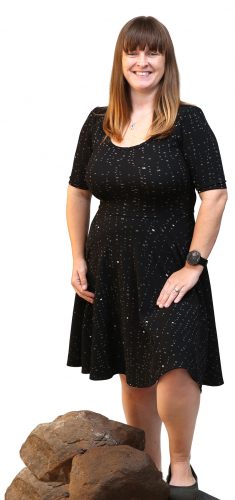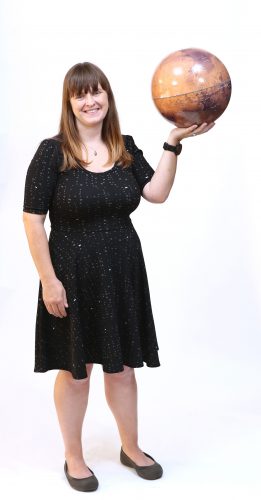Rhiannon Mayne Collects Meteorites
TCU’s resident meteorite expert explores clues about Earth’s beginnings.
Rhiannon Mayne Collects Meteorites
TCU’s resident meteorite expert explores clues about Earth’s beginnings.
The native of Northamptonshire in the United Kingdom traded childhood astronaut ambitions for a career in geology. Now TCU’s Oscar and Juanita Monnig Endowed Chair of Meteoritics and Planetary Science, the associate professor of geology is a pre-eminent expert on meteorites. Mayne specializes in researching differentiation, or looking for clues about how extraterrestrial rocks formed over time. After a postdoctoral fellowship at the Smithsonian Institution, Mayne became curator of the Oscar E. Monnig Meteorite Gallery in 2009.

Rhiannon Mayne is the first official curator of the Oscar E. Monnig Meteorite Gallery. Photo by Carolyn Cruz
The Monnig gallery’s meteorite collection features samples of more than 2,300 rocks with origins in our solar system’s asteroid belt. If visitors to the gallery leave with one takeaway, what would you hope it is?
If you want to understand Earth, you have to look at meteorites. They take us to places we can’t go. We can’t go down to the core of the Earth, no matter what Hollywood tells us, and the only real way we have of looking at anything like the Earth’s core is to look at meteorites. They also take us to a time we don’t see. Earth is so active, and we’ve destroyed at least half-a-billion years of its history. If you want to understand what happened in the half-a-billion years, you have to look to meteorites.
Are you attempting to grow the gallery in a specific direction with new acquisitions?
When Oscar Monnig gave us the collection, there were fewer than 400 different meteorites. There were a lot of some of them because he collected everything, but only 400 different ones. And when I joined the collection, [unofficial curator] Art Ehlmann had traded those, used the endowment to sort of build up the collection to just over 1,400 different meteorites. I’ve been here [since 2009], and we’ve added another 1,000 different meteorites.
I’m always trying to grow the collection behind the scenes because we are one of the two largest university-based collections in the world. And I think that’s a huge feather in TCU’s cap.
I try, because funds are limited, to add things that the collection doesn’t have in great quantity, things that are special. I have a soft spot for Texas meteorites. If a Texas meteorite becomes available, I’m normally going to try and procure it.
Have some meteorites been on Earth for thousands of years or longer?
Yes. They can be very weathered. A lot of the meteorites that are picked up in the desert, you see a lot of rusting in iron because they were formed in an atmosphere pretty much without any oxygen.
Most meteorites are what we call finds, which means someone just happened across them. There are a certain number of falls that occur every year, which means you see it fall and you go and pick it up. Those are highly sought after because they’re pristine, and if they’re of an unusual type, a lot of the time you don’t want them altered by water. So if you can pick them up when they first fall, when there’s no terrestrial contamination, they haven’t been rained upon, that’s really valuable to science.
In 2010, you traveled to Antarctica to search for meteorites. Was the expedition a success?
I spent just under two weeks training in McMurdo [station] and then six weeks camping on the ice — eight of us in the middle of the continent, looking for meteorites.
We found 1,250 meteorites. Antarctica concentrates them for you. When you’re looking in Texas, you’re pretty much looking at where it fell. In Antarctica, anything that falls on the ice sheet is going to get buried in the ice sheet, and we know the direction the ice is moving in, so if you go to an area where the ice is constantly being removed, you’re going to keep exposing new meteorites at the surface.
I’m always trying to grow the collection behind the scenes because we are one of the two largest university-based collections in the world. And I think that’s a huge feather in TCU’s cap.
Rhiannon Mayne, TCU's Oscar and Juanita Monnig Endowed Chair of Meteoritics and Planetary Science
You were holding monthly sessions where anyone could bring in a rock they suspected to be a meteorite. You’ve had to temporarily suspend the sessions but want to resume them, as people came from all over the state for your expert opinion. Why do you think people are fascinated with the idea of holding something that came from space?

Rhiannon Mayne, associate professor and curator of the Oscar E. Monnig Meteorite Gallery, holds a globe of the planet Mars. Photo by Carolyn Cruz
The unknown is so attractive, and I think it’s also something that harkens back to a lot of people’s childhoods. I have a 4-year-old, and I think [children] see the world slightly differently. A lot of adults never quite lose that attitude for space, which is exciting in a way. There’s still something very thrilling about holding a piece of Mars or holding a piece of the moon and thinking about how astonishing the solar system is.
I have pieces in the collection, lots of the most common types, but they contained the earliest solids that formed in the solar system. Sometimes I have to stop and remind myself what I am surrounded by. I might see these every day, but what is in this cabinet is truly astonishing in the grand scheme of things.
You have been publishing papers on differentiation and meteorites specific to the asteroid Vesta. Where is your research headed next?
I’ve made the shift to try to work on stuff within the collection because it’s so amazing. I basically have a scientific playroom upstairs. As a curator, it’s very easy to log them as, “This is this number; this is that number,” but I’ve started looking at them as, “What questions can this rock answer?”
I just had a master’s student who has gone off to work on a Ph.D. We’re going to be using rocks from the collection in his research to try and answer some really big-scale pictures on the solar system, trying to test some of the models for the formation of our solar system.
One of the things that a lot of people say now is that the planets didn’t form where they are today. So if you look at the giant planets, the idea is that they have migrated from where they initially formed. We’re looking at doing some research on rocks in the asteroid belt to say, “Well, let’s test that. Can we still see patterns that we would have expected in the asteroid belt today?” If we can, that might tell us something about how these planets migrated. If you move something as big as Jupiter around in the solar system, it affects everything.
— Caroline Collier
Editor’s Note: The questions and answers have been edited for clarity and length.

Your comments are welcome
Comments
Related reading:
Research + Discovery
Eclipsing Research
TCU astronomer Kat Barger shines a light on the Milky Way’s origins.
Features
Adam Fung’s Uncommon Arctic Adventure
The art professor is acting as an Arctic ambassador and filmmaker after his 19-day residency in the Far North.
Alumni
Lunar exploration . . . Walter Kiefer ’84
For scientist Walter Kiefer ‘84, the mysteries of the moon are more than poetic.